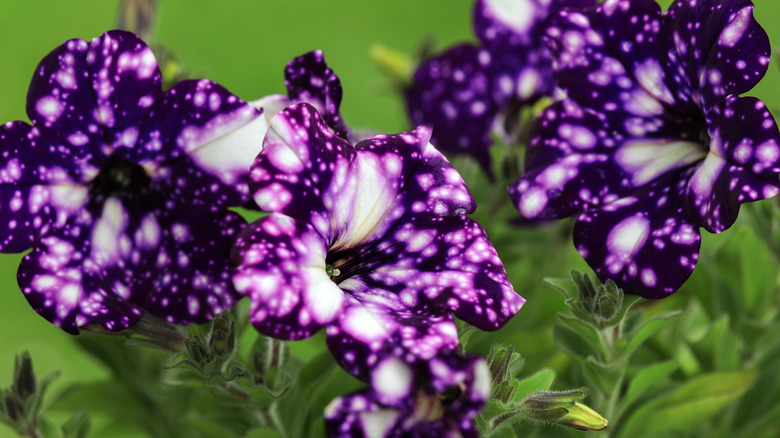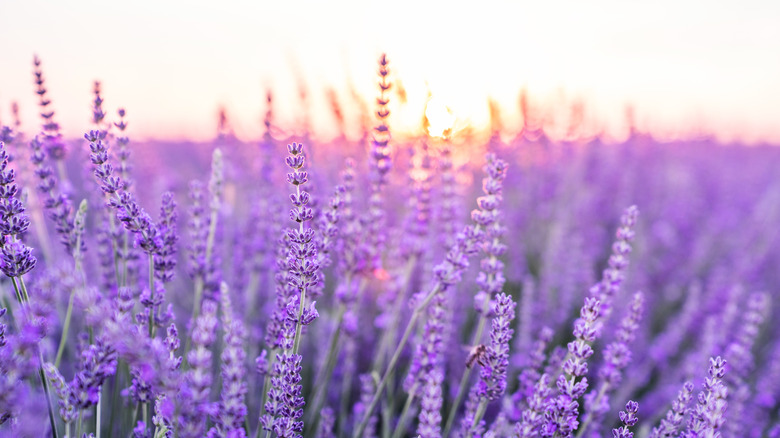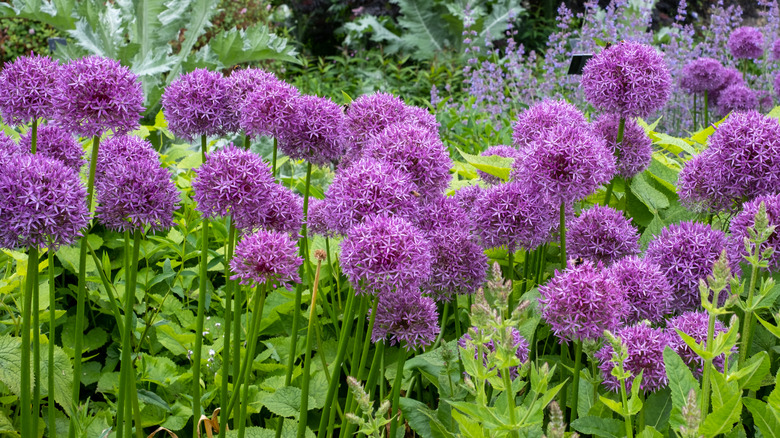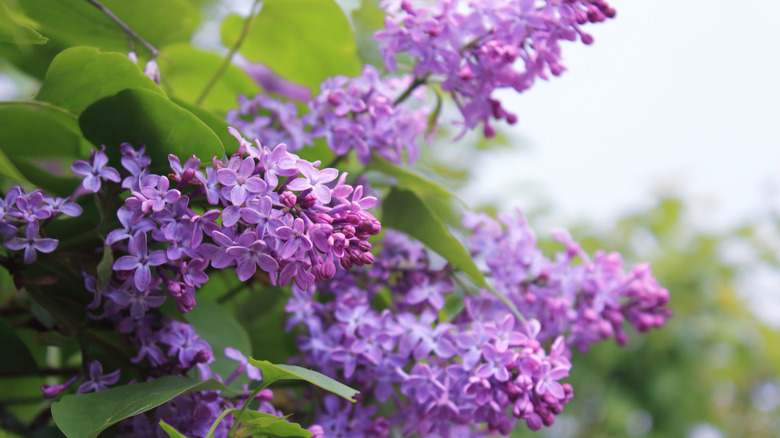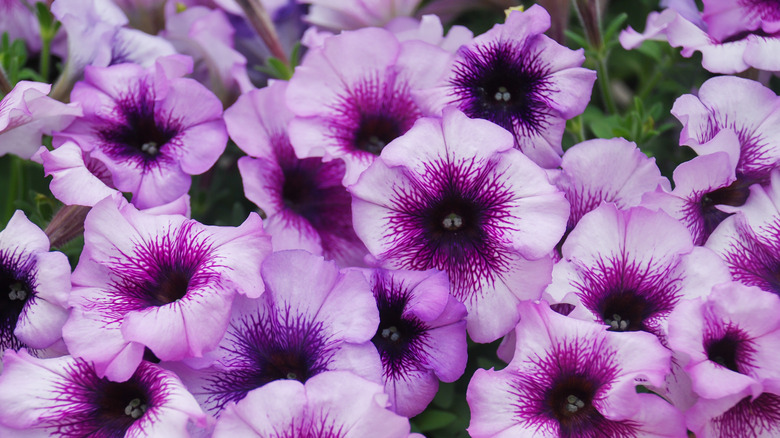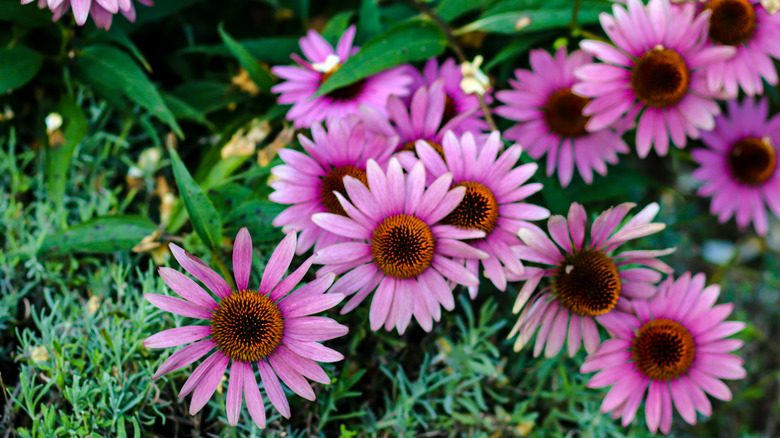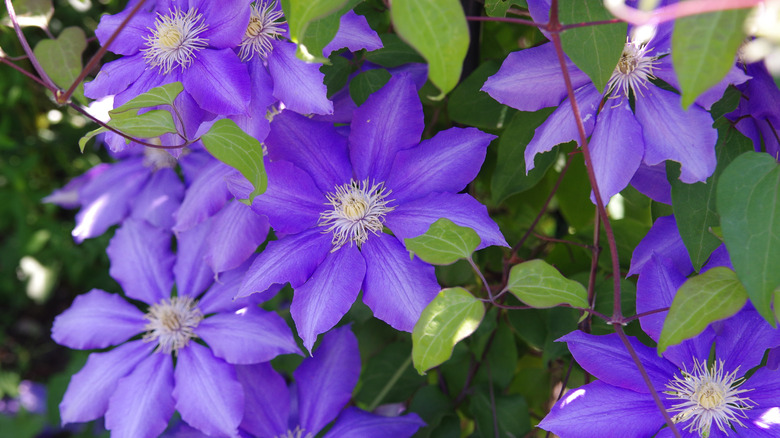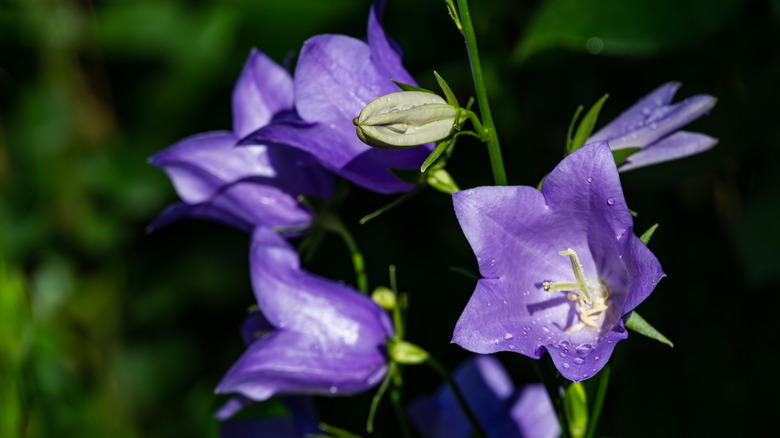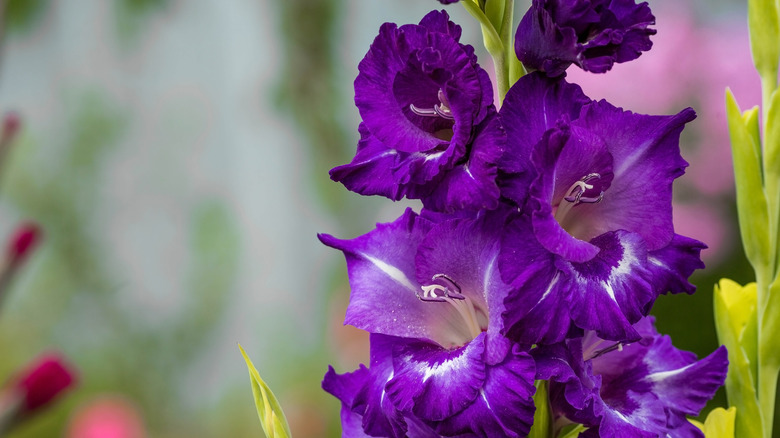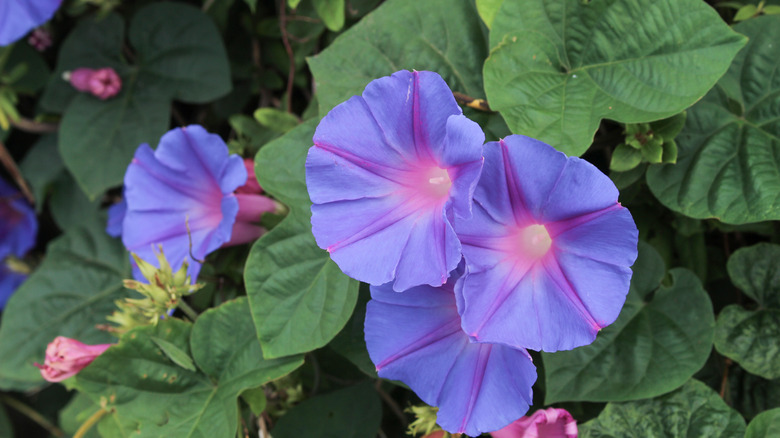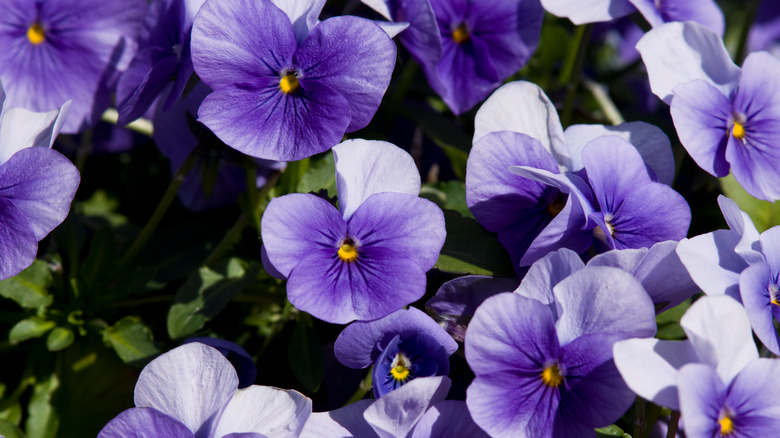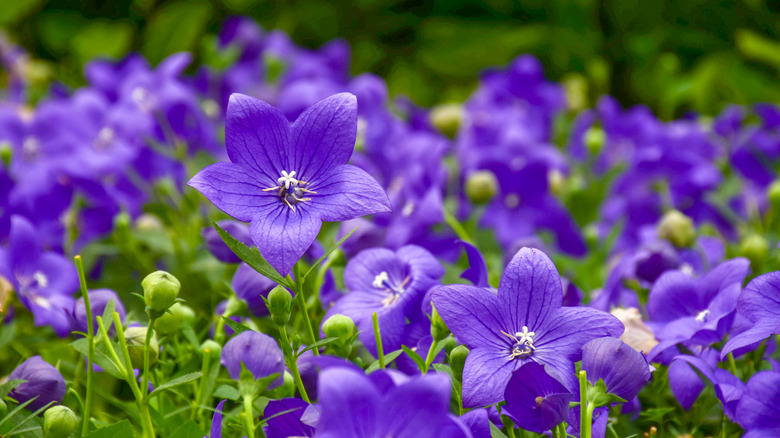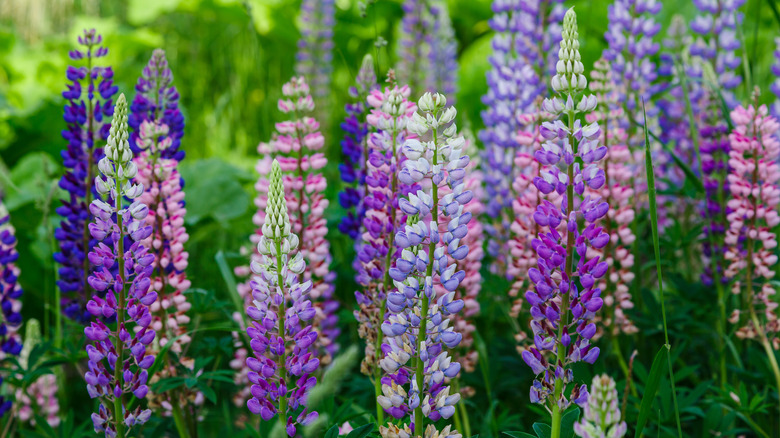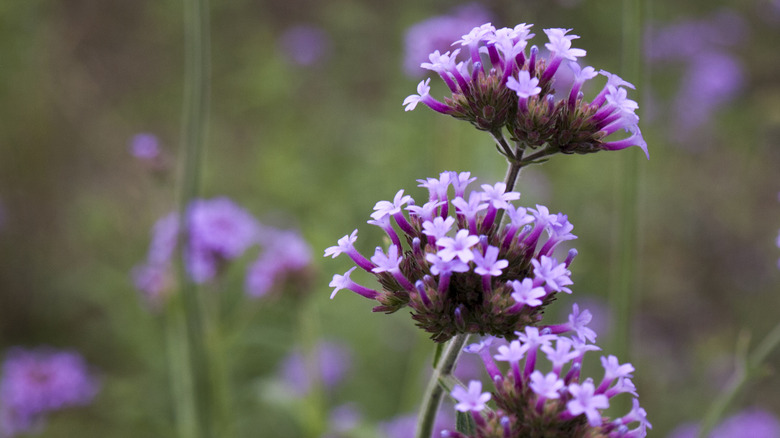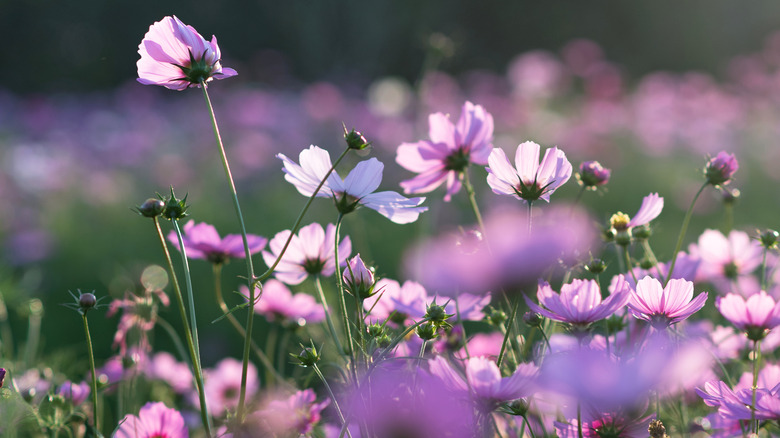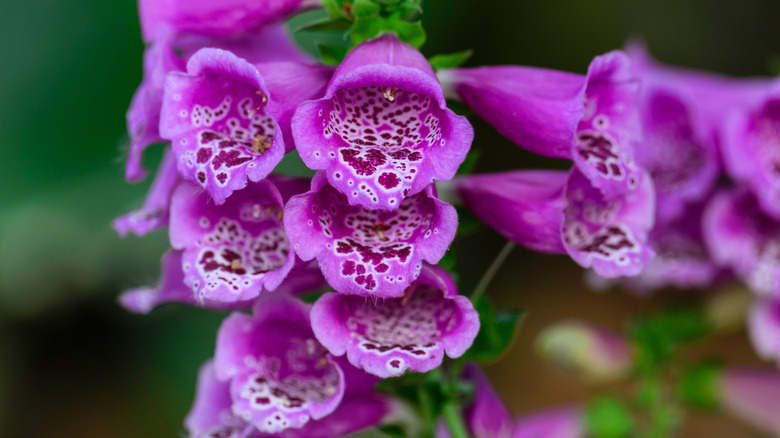15 Best Purple Plants For Your Flower Garden
If you're trying to decide what to plant in your garden, there are a few things that you might want to take into consideration. For instance, you may want to choose plants that are the easiest options for beginning gardeners or ones that are drought resistant, depending on the conditions in your area. On top of that, you'll want to note the amount of sun your garden gets and what sort of soil you have to work with. It's also a good idea to figure out where your home is located when it comes to USDA plant hardiness zones (which can tell you which plants will do well in your garden and which will struggle).
Or you might simply be interested in focusing on a certain color that makes you happy or matches the tones in the exterior of your home, like radiating red plants or eye-pleasing purple. If the latter idea intrigues you, then keep reading because we have 15 of the best purple plants for your flower garden as well as all of the key information you need in order to help them grow to their full purple potential.
1. Lavender
Lavender (scientific name Lavandula) is a popular purple choice thanks to the fact that it both looks and smells beautiful. Chances are you've worn a lavender-colored item of clothing and enjoyed a fair share of lavender-scented candles, and the shade looks just as lovely in a garden. However, Everyday Health points out that there are plenty of other reasons to have lavender around, such as the fact that it can help with both pain and breakouts, as well as help you sleep on top of a long list of additional physical benefits.
Bloom Season: spring to mid-summer
USDA Growing Zone: most do well in zones 5 to 9
Growing Conditions: Garden Design notes that there are different varieties of the plant — such as English Lavender, French Lavender, and Spanish Lavender — that will flourish in slightly varied conditions
Soil Type: does well in most soil, but keep away from overly wet areas
Size: 1 to 3 feet tall
2. Allium
Allium (scientific name Allium) is a family of plants that includes an ornamental perennial as well as familiar offerings like garlic, onions, and shallots, according to Gardener's Supply Company. With a long stem that is topped with a puffy purple poof of petals, it's certainly a plant that you'll want to grow to its full potential, which is why The Spruce notes that bulbs should go into the ground during the fall. It's also important to know that this plant can be dangerous to animals. That means it's best to keep your dogs and cats away from the garden if you opt for this particular purple plant.
Bloom Season: summer
USDA Growing Zone: zones 3 to 9
Growing Conditions: an area that gets good drainage and lots of sun
Soil Type: rich soil
Size: up to 4 feet tall
3. Lilac
Lilac (scientific name Syringa) is another popular choice thanks to both its stunning purple color as well as its intoxicating scent. Growing on shrubs or even trees, per Fine Gardening, you'll definitely want to give your lilac enough space to grow. Gardenia explains that once it's off and blooming, get ready to enjoy the sight and smell as well as all of the critters that will love to stop by to visit your lilac.
Bloom Season: around the end of spring
USDA Growing Zone: zone 3 to 7 (though sometimes 8 and 9)
Growing Conditions: full sun
Soil Type: well-drained and rich soil that's neutral to alkaline
Size: 5 to 15 feet tall
4. Petunias
Petunias (scientific name Petunia) come in a wide variety of gorgeous colors and patterns, as you can see in both the pic above as well as the intro photo (in case you were wondering what those incredibly speckled flowers were). Home Stratosphere lists 38 different varieties that come in red, pink, yellow, white, blue, and, yes, oh-so-pretty purple. They can even be more than one shade, which offers a captivatingly colorful display that you'll absolutely adore. On top of that, The Old Farmer's Almanac explains that there a range of different petunias such as multiflora, grandiflora, floribundas, and millifloras, as well as spreading or trailing petunias.
Bloom Season: spring through summer
USDA Growing Zone: zones 9 to 11
Growing Conditions: each type requires specific space, conditions, and care. However, Gardening Know How notes that taking care of petunias basically comes down to what most plants want: sun and regular (though not over-) watering
Soil Type: light and/or sandy soil
Size: depending on type, can be anywhere from 6 inches to 8 feet tall and 1 to 4 feet wide
5. Purple Coneflowers
If you're looking for a flower that has a softer purple shade, then you might want to add some purple coneflowers (scientific name Echinacea or Echinacea purpurea) to your garden. Originally from the prairies, according to The Spruce, they are a delicate, daisy-like purple flower that is stronger than it might seem, as well as being simply stunning.
Bloom Season: summer to fall
USDA Growing Zone: zones 3 to 8
Growing Conditions: full sun
Soil Type: well-drained soil is ideal, but coneflowers can stand up to some rather harsh conditions, such as dry soil
Size: 2 to 4 feet
6. Clematis
Clematis (scientific name Clematis) is another plant that grows in a variety of stunning shapes and captivating colors, according to Better Homes & Gardens, and that includes pure purple. Actually a vine that blooms with flowers that boast stellar star-like petals (six to eight of them depending on the plant), to give this plant the best conditions, Longfield Gardens suggests providing your clematis a trellis, fence, or wall to climb as it gets bigger. Gardener's Supply Company also notes that some clematis plants will need to be pruned, so be sure to watch out for dead sections that you'll need to carefully cut away.
Bloom Season: mid-summer to fall
USDA Growing Zone: zones 4 to 9
Growing Conditions: prefers a sunny location as well as an area that will keep the roots wet and cool
Soil Type: rich, well-drained soil
Size: a few feet off the ground to 20 feet tall
7. Bellflowers
Bellflowers (scientific name Campanula) are a perennial plant that has a common name which — as you might have guessed — is inspired by the bell-like shape of its flower, according to Garden Lovers Club. With a dark purple color that can almost seem blue in a certain light, these fabulous flowers are a stunning addition to any garden.
Bloom Season: late spring to summer
USDA Growing Zone: Gardening Know How specifically notes that USDA plant hardiness zones 4 and above are best for bellflowers. However, if you're willing to offer some additional TLC, then they might be able to grow in a zone 3 area
Growing Conditions:fFull sun
Soil Type: decently drained soil
Size: up to 3 feet in both height and width
8. Gladiolus
Coming from the iris family, gladiolus (scientific name Gladiolus) is an ornamental flower that is simply gorgeous. Growing on a tall stalk, the deep purple flowers themselves are vibrant, frilly, and beyond beautiful.
Bloom Season: summer
USDA Growing Zone: according to Gardener's Path, gladiolus are a perennial that requires USDA hardiness zones in the 7 to 11 range. Outside of that, the plants are known as annuals
Growing Conditions: full sun
Soil Type: well-drained soil
Size: The Old Farmer's Almanac points out that the stalks of the plants can grow up to 2 to 5 feet while the flowers can be anywhere from less than 3 inches to over 5 inches
9. Morning Glory
Along with having a gorgeous name, Morning Glory (scientific name Ipomoea) is the perfect plant to add a bit of purple to your garden if you happen to be looking for something that you might spot at an idyllic cottage, as Garden Design notes. It's also a great choice for those who prefer to opt for plants that tend to do well without constant attention. However, while this plant is easy to grow — in that, it mostly takes care of itself if placed in an ideal spot — it is also a plant that can take over your garden if you're not willing or able to keep it in place. You should also be aware of the fact that this is another plant that can be toxic to animals.
Bloom Season: late summer or early fall
USDA Growing Zone: zones 3 to 10
Growing Conditions: full sun
Soil Type: moist soil
Size: The Spruce explains that Morning Glories are a vine that can grow 12 feet or more every single season
10. Purple Pansy
Purple pansies (scientific name Viola tricolor var. hortensis) have a name that makes them an obvious choice if you're looking for a plant for your garden in that particular color. However, what's not so straightforward is which kind of purple pansy you should choose. That's because there are various kinds that are all beautiful in their own way. For instance, Viola "Celestial Midnight" are deep purple with a spot of bright yellow in the center of the flower, while Viola "Celestial Twilight" are a much lighter purple and even have yellow petals in the mix. Viola odorata or Sweet Violets, on the other hand, offer little pops of blueish-purple petals.
Bloom Season: The Old Farmer's Almanac explains that the flowers can thrive if planted in both spring and fall, but they prefer things on the cooler side
USDA Growing Zone: zones 4 to 8
Growing Conditions: partial sun
Soil Type: well-drained but moist
Size: 6 to 12 inches tall and 4 to 12 inches wide
11. Balloon Flowers
Balloon flowers (scientific name Platycodon grandiflorus) will inflate — or, rather, bloom — with petals that give the flower a star-like shape. Indeed, while they may not exactly resemble their namesake, the powerful purple color will make them hard to pass up. When caring for your balloon flowers, Gardener's Path notes that they are relatively tough plants, but you'll want to be sure to stay away from the delicate roots.
Bloom Season: late July and into August
USDA Growing Zone: zones 3 to 8
Growing Conditions: a sunny spot or partial shade
Soil Type: moist
Size: up to 2 to 3 inches each; the plant itself can reach 1 to 2.5 feet tall as well as more than a foot in width, according to The Spruce
12. Lupine
Another purple plant that stands tall, without typical petals, lupines (scientific name Lupinus) instead boast racemes that add a unique look and feel to your garden. While the plants aren't into extreme heat or overly sunny days, Larry Hodgson, author of "Perennials for Every Purpose," explained to Garden Design, "Just being able to grow lupines would be reason enough to move to a cool-summer climate." He added, "Not only do lupines thrive, but they self-sow with a vengeance."
Bloom Season: spring
USDA Growing Zone: zones 4 to 8
Growing Conditions: either full sun if you live in a cooler area or partial sun if your home is somewhere hot
Soil Type: loose, rich, and moist soil
Size: 1 to 4 feet in height
13. Verbena
A plant that's perfect for filling in the gaps in and around your garden, according to Gardenia, verbena (scientific name Verbena) offers you teeny-tiny flowers that bunch together in beautiful bursts of purple blooms. As both an annual plant and a perennial, they can stick around throughout the season so that you're able to enjoy them for an extended period. Better Homes & Gardens points out that you'll want to watch out for mildew when it comes to verbena because the powdery white garden menace can keep the plant from growing to its full potential.
Bloom Season: spring to fall
USDA Growing Zone: zones 7 to 9
Growing Conditions: full sun
Soil Type: well-drained soil
Size: 6 inches to 3 feet in height and 20 inches across depending on which exact variety you choose
14. Cosmos
Cosmos (scientific name Cosmos) are annuals that seem to be reaching for the stars with long, light purple petals that can and can almost look pink when the sun shines through them or — as the Flower Essence Society points out, can lean towards a magnificent magenta shade. On top of that, Homes & Gardens notes that the flowers have a sunny yellow center which is where bees love to find pollen.
Bloom Season: summer
USDA Growing Zone: zones 2 to11
Growing Conditions: full sun and lots of space
Soil Type: they can stand up against less-than-ideal soil, but for best results when it comes to these pretty purple flowers, the dirt just needs to drain
Size: up to 5 feet tall
15. Foxglove
Foxglove (scientific name Digitalis) is the kind of plant that looks as cool as it sounds. Boasting plenty of purple cup-shaped tubes, each flower is just as stunning inside as it is outside thanks to its artful patterns. Beyond that, The Spruce explains that these plants can either be biennials (which are plants that will survive for just two seasons) or perennials if given the right conditions. Another plant that can be both medicinal and poisonous, according to WebMD, Better Homes & Gardens stresses the poisonous aspect and urges gardeners to be cautious when it comes to choosing the right (that is, safest) spot for these plants.
Bloom Season: early summer
USDA Growing Zone: zones 4 to 10
Growing Conditions: full sun
Soil Type: moist soil
Size: 1 to 8 feet tall and 1 to 3 feet wide
